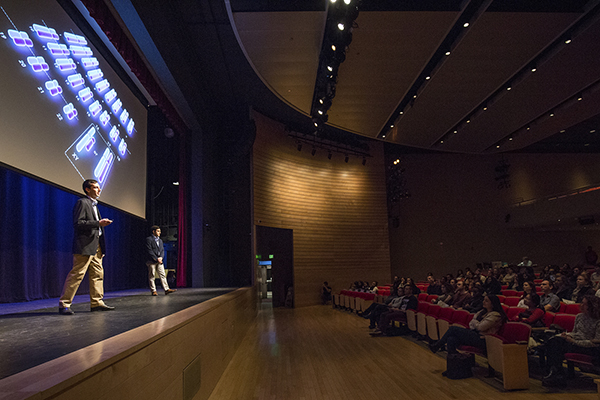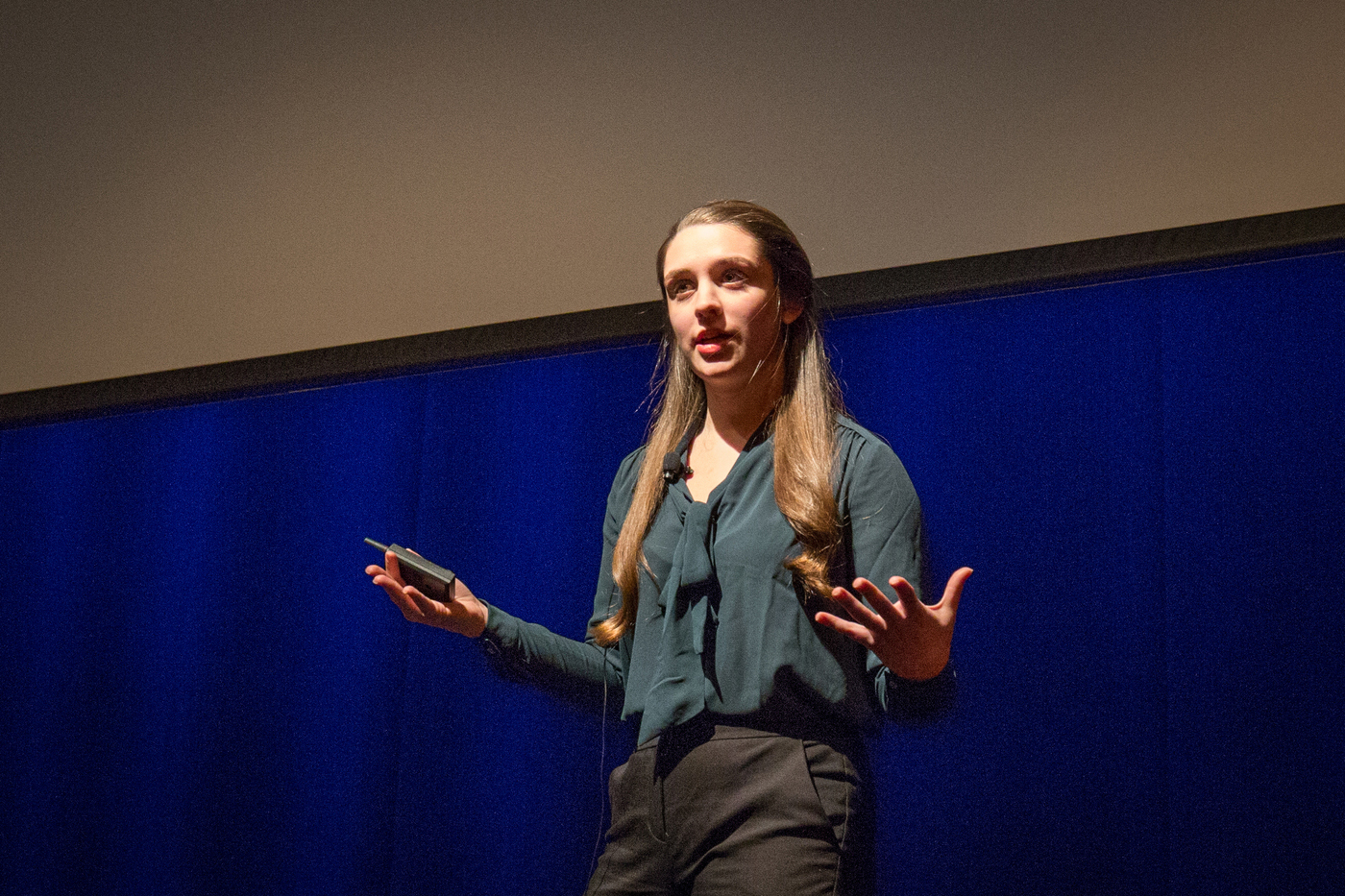Students wow audience with research ranging from organ regeneration to quantum solar energy

Tyler Jensen, S’17, explores the regeneration of organs in salamanders as a step toward regenerating organs in humans. Kritika Singh, E’21, heads a global organization to eradicate malaria. Anirudh Duggal, MA’18, a computer-security expert, hacks into hospital computer systems to help build attack-proof networks for the healthcare sector.
These are just three of the nine research projects students described—with eloquence and insight—on Monday night at NU Talk 2017 in Blackman Auditorium. Presented by the Northeastern Biology Club in association with the College of Science, the College of Engineering, and the College of Computer and Information Science, the TEDx-like forum featured 11 student speakers introduced by faculty members or deans who had supported their work.
NU Talk, a student-run event that launched two years ago, is open to all Northeastern students by application. It shows the impressive range of research students are conducting in labs on campus and in coops around the world.
“The program ties into the fundamental goals of the university,” Kenneth Henderson, dean of the College of Science, said in opening remarks. “It represents a cross-fertilization across fields, the communication of science to a general audience.”
From gene-editing to quantum solar energy
Communicate the speakers did, with vibrant visuals and polished explanations of their research honed with the coaching help of Christi Barb, lecturer in the College of Arts, Media and Design, to a cheering crowd of some 500 students, faculty, and staff.
Fazli Bozal, S’17, and Guillaume Harmange, S’19, both biochemistry majors, addressed the therapeutic possibilities of the gene-editing technology CRISPR. In accessible terms, they described the two primary components of the tool: the enzyme Cas9, which acts as a pair of molecular scissors, cutting a strand of DNA to remove certain genetic sequences or add others, and a piece of RNA, called guide RNA, that directs Cas9 to the appropriate spot on the strand.
“CRISPR has the potential to revolutionize medicine and biotechnology,” said Bozal, citing his coop research applying it to sickle cell anemia. Harmange pointed to other therapeutic possibilities, including curing HIV infection.
Taking the audience to a more distant realm, Emma Kaeli, E’18, a chemical engineering major, explained how quantum dot solar cells could improve solar energy efficiency. Her enthusiasm for the cause was infectious.

Emma Kaeli, E’18, explains how quantum dot solar cells can improve solar energy efficiency at NU Talk 2017. Photo by Alastair Pike for Northeastern University
“We need renewable sources, not coal and oil,” she said, pointing to the havoc that will result if the planet’s temperature increases by 2 degrees Celsius above preindustrial levels. “Solar is one of them.” But solar energy has limitations, she said, including the current high cost: 10 cents per kilowat hour. “For solar to be sustainable, it must get to 3 cents per kilowat hour,” she said. Enter quantum dot solar cells, which use nanometer-size semiconductor particles to absorb light and convert it into electricity rather than bulk materials such as silicon.
“We can get there,” said Kaeli, who worked on the technology on co-op at the National Renewable Energy Laboratory in Golden, Colorado. “We need students passionate about renewable energy, and we need constituents to call their legislators and say they believe in climate change. The future that relies on the sun is a reliable future.”
Tonight we aimed to paint a picture of the future and divine our role in that future. The future is you—your passion, vision, and drive.
Alexander Farahani
S’18
Andrew Tu, E’20, a computer engineering major, brought the audience not just down to Earth but to the depths of the ocean. He has worked with associate professor Stefano Basagni developing underwater wireless networks to bring real-time scientific data to researchers on land. His responsibilities included testing the efficiency of various networking protocols. “Radio waves don’t propagate underwater,” said Tu. “We need acoustic communications.” The project, called the Northeastern University Marine Observatory NETwork, could be applied to activities from environmental monitoring to surveillance for defense measures.
Tu is now turning his attention learning about networking autonomous underwater vehicles, free-swimming robots that survey the ocean floor. “Today we can scale up these AUVs, connecting many of them to create a much more efficient network,” he said.
‘The future is you’
Other topics covered were the value of citizen science, the role of electronic records in streamlining healthcare, and the promise of Elon Musk’s Hyperloop.
This year’s NU Talk was impressively organized, from the thumping music that greeted the entering audience to the coordinated bow by the participants and organizers—Alexander Farahani, S’18, Shalin Shetty, S’19, and Joseph Rissman, S’19—at the close of the event. “Traditionally NU Talk is much smaller,” explained Farahani during intermission. This year he, Shetty, and Rissman spent 11 months planning the event, beginning with a 15-page formal proposal submitted to the participating colleges.
Farahani left attendees with this thought before they filed out of Blackman to the post-talk reception in Curry Student Center. “Tonight we aimed to paint a picture of the future and divine our role in that future,” he said. “The future is you—your passion, vision, and drive.”





